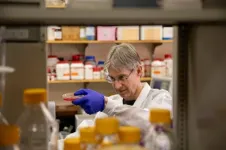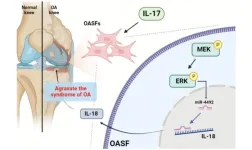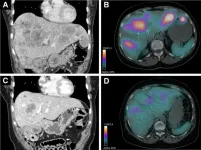(Press-News.org) Living organisms often create what is needed for life from scratch.
For humans, this process means the creation of most essential compounds needed to survive. But not every living thing has this capability, such as the parasite that causes malaria, which affected an estimated 249 million people in 2022.
Virginia Tech researchers in the College of Agriculture and Life Sciences found that by preventing the malaria parasite from scavenging fatty acids, a type of required nutrient, it could no longer grow.
“The key to this breakthrough is that we were able to develop a screening method for the malaria parasite and block this process,” said Michael Klemba, associate professor of biochemistry and principal investigator on the project. “While very much in its infancy, the results could open the door to a new way to fight malaria.”
Malaria is caused while the parasite is replicating in human red blood cell and it relies on scavenging, rather than creating, to satisfy its need for fatty acids. Many fatty acids are obtained by metabolizing a class of host lipid, called lysophospholipids. However, scientists didn't know how the parasite releases fatty acids from the host lipids.
The Virginia Tech research team did experiments with infected red blood cells and found chemicals that can stop the parasite from getting the needed fatty acids. Researchers discovered that two enzymes were instrumental in breaking down host lipids to release the fatty acids the parasite needs. These enzymes work in different places: One works outside in the red blood cell, and the other works inside the parasite.
When scientists removed these two enzymes, they found that the parasite struggled to get the needed fatty acids and couldn't grow well. This was especially true when that host lipid was the only fatty acid source available. When both enzymes were stopped from working, either by changing the parasite's genes or by using drugs, the parasites couldn't grow in human blood.
This shows that breaking down the host lipid, called lysophosphatidylcholine, to get fatty acids is critical for the malaria parasite's survival in our bodies and that targeting these two enzymes could be a new way to fight malaria.
The research was published today by Proceedings of the National Academy of Sciences of the United States of America and was funded by a National Institutes of Health grant, United States Department of Agriculture Hatch funding, and through the Department of Biochemistry at Virginia Tech.
Laying the groundwork
In 2017, a study came out that showed when lysophosphatidic acid levels drop in the host that the malaria parasite, known as Plasmodium falciparum, converts into a form that can be taken up by mosquitoes. P. falciparum causes malaria while replicating in host erythrocytes, or red blood cells, and relies on scavenging rather than synthesis, or the creation of compounds, to satisfy its need for fatty acids.
This seemed to be an important environmental cue, Klemba said, and that there was also evidence that host lipids were a preferred source of fatty acids.
“There wasn't clarity on what the metabolic pathways were,” he said. “If we could show that that these metabolic pathways were useful, then that would be an important contribution to the field.”
For Klemba, this was an important question to answer and one that his lab – and students – were in a unique position to do. Two graduate students worked on the project - Jiapeng Liu ’23, now a postdoctoral scholar at Rutgers University, and Christie Dapper, a former professor at Virginia Tech. Liu was the lead author and Katherine Fike assisted with the project as a research specialist.
“There are two enzymes that are really important for this process: one is inside the parasite, and the other is exported into the host cell,” Klemba said. “Which is not typical of metabolic processes as they are typically carried out within the parasite. Why did the parasite find it useful to put one of these enzymes into the host? We have some ideas that that could be involved in host modification, which could be that the parasite remodels the red cell once it's once it's set up shop.”
The researchers found that only removing one of the two enzymes, which they named XL2 and XLH4, doesn’t do anything. Both have to be removed to inhibit parasitic growth.
Future work
There are some limitations of the discovery: The research was conducted only using a culture dish, commonly referred to as in vitro. The researchers also are not sure if the compounds used to inhibit the two enzymes are toxic.
Some level of toxicity is expected, Klemba explained, and it may be possible to engineer the toxicity out of the compounds.
“But that could be a major challenge,” he said.
In the meantime, this discovery could open the door to therapeutic treatments for malaria.
END
Virginia Tech researchers discover that blocking an essential nutrient inhibits malaria parasite growth
The four-year study could lead to a new way to fight malaria, one of the most devastating infectious diseases in the world.
2024-02-13
ELSE PRESS RELEASES FROM THIS DATE:
Children's Hospital Los Angeles researchers uncover social and economic factors that influence acute liver failure in children—and ways to overcome them
2024-02-13
Imagine your healthy child gets sick—so sick that you take them to the emergency department. You are shocked to find out that their liver is failing, and they will need a transplant to survive. Studies show that their chances of survival are higher the faster they can get to a hospital that performs liver transplants. But what factors affect how quickly that happens?
Pediatric acute liver failure, also called PALF, is a life-threatening condition that emerges with very little warning in previously healthy children. It is rare, affecting about 5,000 children in the United States a year, and can result from viral ...
Uncovering insights about prostate cancer risk and genetic ancestry
2024-02-13
This study included larger groups of people from African, Hispanic and Asian ancestries than many other previous studies.
A recent study involving scientists from the U.S. Department of Energy’s (DOE) Argonne National Laboratory has uncovered insights into the prostate cancer risks of people from a variety of genetic ancestries. The project, which was led by the University of Southern California, included large increases in representation among men of African, Hispanic and Asian ancestries, that were contributed in part by an ongoing collaboration between the U.S. Department of Veterans Affairs (VA) and DOE as ...
A century of reforestation helped keep the eastern US cool
2024-02-13
American Geophysical Union
13 February 2024
AGU Release No. 24-5
For Immediate Release
This press release and accompanying multimedia are available online at: https://news.agu.org/press-release/a-century-of-reforestation-helped-keep-the-eastern-us-cool/
A century of reforestation helped keep the eastern US cool
Much of the U.S. warmed during the 20th century, but the eastern part of the country remained mysteriously cool. The recovery of forests could explain why
AGU press contact:
Liza Lester, +1 (202) 777-7494, news@agu.org (UTC-5 hours)
Contact information for the researchers:
Kim ...
IL-17 promotes IL-18 production in osteoarthritis synovial fibroblasts via…
2024-02-13
“This study provides novel insights into the pathogenesis of OA and suggests a potential therapeutic target in OA treatment.”
BUFFALO, NY- February 13, 2024 – A new research paper was published in Aging (listed by MEDLINE/PubMed as "Aging (Albany NY)" and "Aging-US" by Web of Science) Volume 16, Issue 2, entitled, “IL-17 promotes IL-18 production via the MEK/ERK/miR-4492 axis in osteoarthritis synovial fibroblasts.”
The concept of osteoarthritis (OA) as a low-grade inflammatory ...
New data speed record on optical fiber
2024-02-13
As data traffic continues to increase, there is a critical need for miniaturized optical transmitters and receivers that operate with high-order multi-level modulation formats and faster data transmission rates. In an important step toward fulfilling this requirement, researchers developed a new compact indium phosphide (InP)-based coherent driver modulator (CDM) and showed that it can achieve a record high baud rate and transmission capacity per wavelength compared to other CDMs. CDMs are optical transmitters used in optical communication systems that can put information on light by modulating the amplitude and phase before it is transmitted through optical fiber.
“Services that require ...
UBCO researchers get to the bottom of non-invasive gut tests
2024-02-13
New research from UBC Okanagan could make monitoring gut health easier and less painful by tapping into a common—yet often overlooked—source of information: the mucus in our digestive system that eventually becomes part of fecal matter.
Correct, what’s in our poop.
Researcher Dr. Kirk Bergstrom and post-graduate student Noah Fancy of UBCO's Biology department discovered a non-invasive technique to study MUC2, a critical gut protein, from what we leave behind in the bathroom.
“MUC2 is like the silent star in our guts. It’s constantly working ...
Radiopharmaceutical therapy controls symptoms and reduces medications in insulinoma patients
2024-02-13
Reston, VA—Peptide receptor radionuclide therapy (PRRT) is effective for clinical control of symptomatic metastatic insulinomas, according to new research published in the February issue of The Journal of Nuclear Medicine. In the largest study to date of metastatic insulinoma patients treated with PRRT, more than 80 percent of patients had long-lasting symptom control, and nearly 60 percent were able to reduce the use of other drugs to treat the disease.
Metastatic insulinoma is a rare malignant neuroendocrine tumor characterized ...
First-of-its-kind ACC registry tracks cardiac procedures performed in ambulatory surgical settings
2024-02-13
The American College of Cardiology’s newest registry offers data-driven insights on cardiac procedures performed in the ambulatory surgery setting through its first-of-its-kind dashboard. The number of cardiac procedures being performed in ambulatory surgery centers has grown significantly in the last decade, leading ACC’s NCDR to create the CV ASC Registry Suite to fit into the established workflow and allow these facilities to measure and compare their patient care and outcomes to similar procedures performed in the hospital outpatient setting.
Ambulatory surgery centers (ASCs) are health care facilities that provide same-day surgical care, ...
Business operations affect fishermen's resilience to climate change, new study finds
2024-02-13
Timothy Frawley has spent the better of the past two decades working in and around commercial fisheries. Born and raised in Casco Bay, Maine, he grew up packing lobsters and pitching bait on Portland’s working waterfront. He has worked in commercial fisheries in California, Alaska and the Mexican state of Baja California Sur.
Throughout his years spent on working waterfronts, Frawley, a postdoctoral researcher affiliated with the University of Maine’s Darling Marine Center, closely observed the ways in which fishermen conducted their business, making decisions about what and how they fished, and how it affected their operations and profit.
“While ...
Not too late to repair: gene therapy improves advanced heart failure in animal model
2024-02-13
Heart failure remains the leading cause of mortality in the U.S. During a heart attack blood stops flowing into the heart. Without oxygen, part of the heart muscle dies. The heart muscle does not regenerate, instead it replaces dead tissue with a scar made of cells called fibroblasts that do not help the heart pump. If there is too much scarring, the heart progressively enlarges, or dilates, weakens and eventually stops working.
“The current thought is that advanced or chronic heart failure, a stage in which the cardiac muscle has become too weak, is a point of no return. The present ...
LAST 30 PRESS RELEASES:
Tracing the quick synthesis of an industrially important catalyst
New software sheds light on cancer’s hidden genetic networks
UT Health San Antonio awarded $3 million in CPRIT grants to bolster cancer research and prevention efforts in South Texas
Third symposium spotlights global challenge of new contaminants in China’s fight against pollution
From straw to soil harmony: International team reveals how biochar supercharges carbon-smart farming
Myeloma: How AI is redrawing the map of cancer care
Manhattan E. Charurat, Ph.D., MHS invested as the Homer and Martha Gudelsky Distinguished Professor in Medicine at the University of Maryland School of Medicine
Insilico Medicine’s Pharma.AI Q4 Winter Launch Recap: Revolutionizing drug discovery with cutting-edge AI innovations, accelerating the path to pharmaceutical superintelligence
Nanoplastics have diet-dependent impacts on digestive system health
Brain neuron death occurs throughout life and increases with age, a natural human protein drug may halt neuron death in Alzheimer’s disease
SPIE and CLP announce the recipients of the 2025 Advanced Photonics Young Innovator Award
Lessons from the Caldor Fire’s Christmas Valley ‘Miracle’
Ant societies rose by trading individual protection for collective power
Research reveals how ancient viral DNA shapes early embryonic development
A molecular gatekeeper that controls protein synthesis
New ‘cloaking device’ concept to shield sensitive tech from magnetic fields
Researchers show impact of mountain building and climate change on alpine biodiversity
Study models the transition from Neanderthals to modern humans in Europe
University of Phoenix College of Doctoral Studies releases white paper on AI-driven skilling to reduce burnout and restore worker autonomy
AIs fail at the game of visual “telephone”
The levers for a sustainable food system
Potential changes in US homelessness by ending federal support for housing first programs
Vulnerability of large language models to prompt injection when providing medical advice
Researchers develop new system for high-energy-density, long-life, multi-electron transfer bromine-based flow batteries
Ending federal support for housing first programs could increase U.S. homelessness by 5% in one year, new JAMA study finds
New research uncovers molecular ‘safety switch’ shielding cancers from immune attack
Bacteria resisting viral infection can still sink carbon to ocean floor
Younger biological age may increase depression risk in older women during COVID-19
Bharat Innovates 2026 National Basecamp Showcases India’s Most Promising Deep-Tech Ventures
Here’s what determines whether your income level rises or falls
[Press-News.org] Virginia Tech researchers discover that blocking an essential nutrient inhibits malaria parasite growthThe four-year study could lead to a new way to fight malaria, one of the most devastating infectious diseases in the world.







